3.5 Perception
KEY THEME
Perception refers to the process of integrating, organizing, and interpreting sensory information into meaningful representations.
KEY QUESTIONS
What are bottom-up and top-down processing, and how do they differ?
What is Gestalt psychology?
What Gestalt principles explain how we perceive objects and their relationship to their surroundings?
As we’ve seen, our senses are constantly registering a diverse range of stimuli from the environment and transmitting that information to the brain. But to make use of this raw sensory data, we must organize, interpret, and relate the data to existing knowledge.
Psychologists sometimes refer to this flow of sensory data from the sensory receptors to the brain as bottom-up processing. Also called data-driven processing, bottom-up processing is often at work when we’re confronted with an ambiguous stimulus. For example, imagine trying to assemble a jigsaw puzzle one piece at a time, without knowing what the final picture will be. To accomplish this task, you would work with the individual puzzle pieces to build the image from the “bottom up,” that is, from its constituent parts.
bottom-up processing
Information processing that emphasizes the importance of the sensory receptors in detecting the basic features of a stimulus in the process of recognizing a whole pattern; analysis that moves from the parts to the whole; also called data-driven processing.
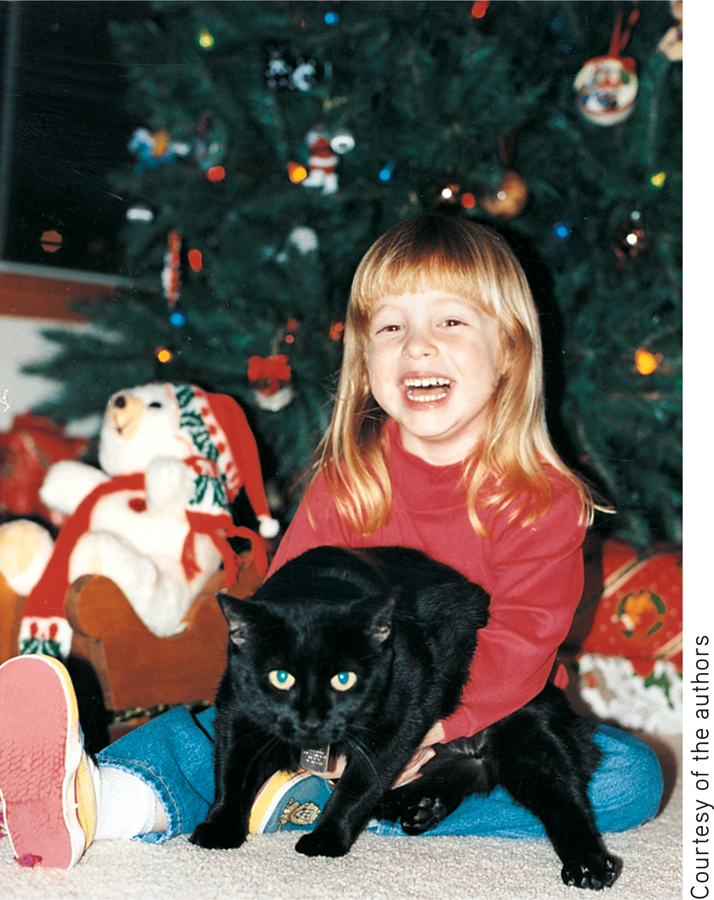
But as we interact with our environment, many of our perceptions are shaped by top-down processing, which is also referred to as conceptually driven processing. Top-down processing occurs when we draw on our knowledge, experiences, expectations, and other cognitive processes to arrive at meaningful perceptions, such as people or objects in a particular context. Cultural experiences also affect perceptual processes, as discussed in the Culture and Human Behavior box, “Ways of Seeing: Culture and Top-Down Processes.”
Both top-down and bottom-up processing are involved in our everyday perceptions. For a simple illustration, look at the photograph (above). Top-down processing was involved as you reached a number of perceptual conclusions about the image. You quickly perceived a little girl holding a black cat—Sandy and Don’s daughter Laura when she was three, holding her cat, Nubbin. You also perceived a child as a whole object even though the cat is actually blocking a good portion of the view of Laura.
top-down processing
Information processing that emphasizes the importance of the observer’s knowledge, expectations, and other cognitive processes in arriving at meaningful perceptions; analysis that moves from the whole to the parts; also called conceptually driven processing.
But now look at the background in the photograph, which is more ambiguous. Deciphering these images involves both bottom-up and top-down processing. Bottom-up processes help you determine that behind the little girl looms a large, irregularly shaped, dark green object with brightly colored splotches on it. But what is it?
To identify the mysterious object, you must interpret the sensory data. Top-down processes help you identify the large green blotch as a Christmas tree—a conclusion that you probably would not reach if you had no familiarity with the way many Americans celebrate the Christmas holiday. The Christmas tree branches, ornaments, and lights are just fuzzy images, but other images work as clues—a happy child, a stuffed bear with a red-and-white stocking cap. Learning experiences create a conceptual knowledge base from which we can identify and interpret many objects, including kids, cats, and Christmas trees.
Clearly, bottom-up and top-down processing are both necessary to explain how we arrive at perceptual conclusions. But whether we are using bottom-up or top-down processing, a useful way to think about perception is to consider the basic perceptual questions we must answer in order to survive. We exist in an ever-changing environment that is filled with objects that may be standing still or moving, just like ourselves. Whether it’s a bulldozer or a bowling ball, we need to be able to identify objects, locate objects in space, and, if they are moving, track their motion. Thus, our perceptual processes must help us organize our sensations to answer three basic, important questions: (1) What is it? (2) How far away is it? and (3) Where is it going?
CRITICAL THINKING
ESP: Can Perception Occur Without Sensation?
ESP, or extrasensory perception, means the detection of information by some means other than through the normal processes of sensation.
ESP (extrasensory perception)
Perception of information by some means other than through the normal processes of sensation.
Do you believe in ESP? If you do, you’re not alone (Ridolfo & others, 2010). Recent surveys conducted by the Associated Press and the Gallup Poll have found that close to 50 percent of American adults “believe in ESP” (Fram, 2007; D. Moore, 2005).
Forms of ESP include telepathy, which is the direct communication between the minds of two individuals; clairvoyance, the perception of a remote object or event, such as “sensing” that a friend has been injured in a car accident; psychokinesis—the ability to influence a physical object without touching it; and precognition—the ability to predict future events.
The general term for such unusual abilities is paranormal phenomena. Paranormal means “outside the range of normal experience.” Thus, these phenomena cannot be explained by known laws of science and nature. Parapsychology refers to the scientific investigation of claims of various paranormal phenomena. Contrary to what many people think, very few psychologists conduct any kind of parapsychological research.
parapsychology
The scientific investigation of claims of paranormal phenomena and abilities.
Have you ever felt as if you had just experienced ESP? Consider the following two examples:
Your sister was supposed to stop by around 7:00. It’s now 7:15, and you “sense” that something has happened to her. Shortly after 8:00 she calls, informing you that her car was rear-ended. Did you experience clairvoyance?
Some years ago, Sandy had a vivid dream that her cat Nubbin got lost. The next morning, Nubbin sneaked out the back door, went for an unauthorized stroll in the woods, and was gone for three days. Did Sandy have a precognitive dream?
Such common instances are sometimes used to “prove” that ESP exists. However, two less extraordinary concepts can explain both occurrences: coincidence and the fallacy of positive instances.
Coincidence describes an event that occurs simply by chance. For example, you have over a thousand dreams per year, most of which are about familiar people and situations. By mere chance, some aspect of some dream will occasionally correspond with reality.
The fallacy of positive instances is the tendency to remember coincidental events that seem to confirm our belief about unusual phenomena and to forget all the instances that do not. For example, think of the number of times you’ve thought something happened to someone but nothing did. Such situations are far more common than their opposites, but we quickly forget about the hunches that are not confirmed.
MYTH !lhtriangle! SCIENCE
Is it true that most psychologists study extrasensory perception (ESP)?
Why do people attribute chance events to ESP? Research has shown that believers in ESP are less likely to accurately estimate the probability of an event occurring by chance alone. Nonbelievers tend to be more realistic about the probability of events being the result of simple coincidence or chance (Dagnall & others, 2007; Rogers & others, 2009).
Parapsychologists attempt to study ESP in the laboratory under controlled conditions. Many initially convincing demonstrations of ESP are later shown to be the result of research design problems or of the researcher’s unintentional cuing of the subject. Another problem involves replication. To be considered valid, experimental results must be able to be replicated, or repeated, by other scientists under identical laboratory conditions. Skeptics claim, and most psychologists agree, that to date, no parapsychology experiment claiming to show evidence of the existence of ESP has been successfully replicated (Hyman, 2010).
One active area of parapsychological research is the study of clairvoyance using an experimental procedure called the ganzfeld procedure (J. Palmer, 2003; Westerlund & others, 2006). (Ganzfeld is a German word that means “total field.”) In a ganzfeld study, a “sender” in one room attempts to communicate the content of pictures or short video clips to a receiver in a separate room. Isolated from all contact and wearing goggles and headphones to block external sensory stimuli, the “receiver” attempts to detect the image that is being sent.
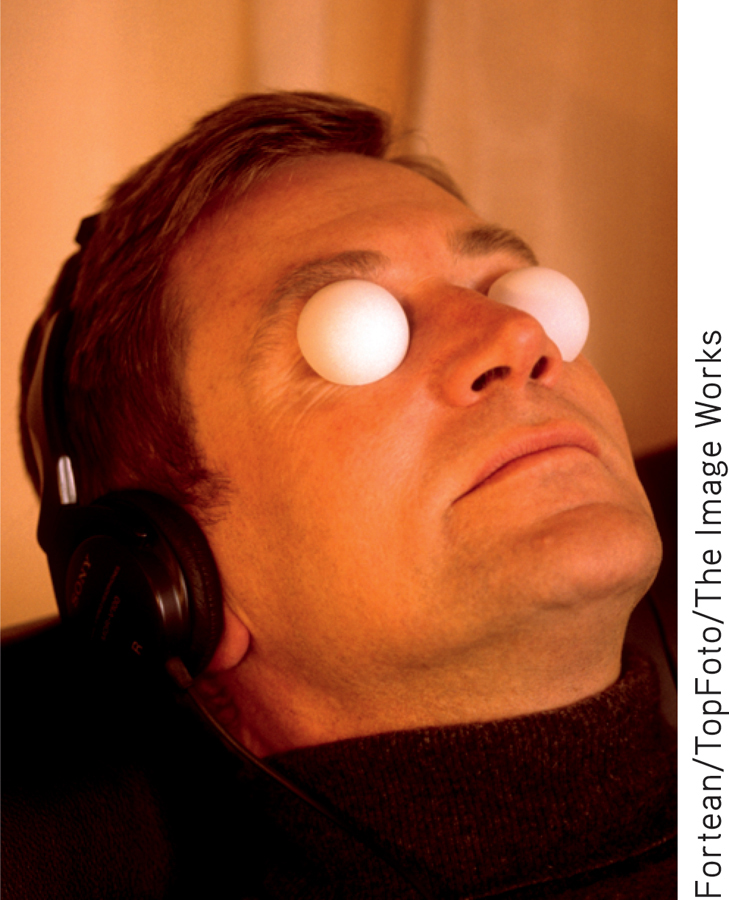
Summarizing dozens of ganzfeld studies conducted over 15 years, Lance Storm and his colleagues (2010; Di Risio & others, 2010) showed a “hit” rate that was well above chance, implying that some sort of transfer of information had taken place between sender and receiver. These results, published in a well-respected psychology journal, Psychological Bulletin, led some psychologists to speculate that there might be something to extrasensory perception after all—and that the ganzfeld procedure might be the way to detect it. But other psychologists, like Ray Hyman (2010), dispute the statistical techniques used and argue that these studies do not offer conclusive proof that ESP has been demonstrated.
The latest salvo in the ESP debate was fired by psychologist Daryl Bem (2011), who tested precognition in a series of nine experiments involving more than a thousand participants. Bem’s ingenious strategy was to “time-reverse” standard psychological tasks, changing the normal order of cause-and-effect.
For example, practicing a list of words makes the words easier to remember. In one experiment, participants taking a memory test better remembered words that they practiced after taking the test. In another experiment, participants predicted the location of a target image on a computer screen before they saw it.
In all, eight of Bem’s nine experiments showed small but statistically significant effects in favor of precognition. These, and similar findings from Bem’s series of experiments, cannot be easily explained (Judd & Gawronski, 2011).
Bem’s research sparked a flurry of media attention, including an appearance on The Colbert Report. It also triggered a firestorm of reaction from psychologists and other scientists (Alcock, 2011; Shermer, 2011). Much of the criticism focuses on the statistical methods used to analyze the data (Fiedler & Krueger, 2013; Rouder & Morey, 2011; Wagenmakers & others, 2011). So far, Bem’s work has not been replicated, but stay tuned.
Of course, the history of science is filled with examples of phenomena that were initially scoffed at and later found to be real. For example, the pain-relieving effects of acupuncture were initially dismissed by Western scientists as mere superstition or the power of suggestion. However, controlled studies have shown that acupuncture does effectively relieve pain and may be helpful in treating other conditions (National Center for Complementary and Alternative Medicine, 2011a).
So keep an open mind about ESP, but also maintain a healthy sense of scientific skepticism. It is entirely possible that some day convincing experimental evidence will demonstrate the existence of ESP abilities (see French, 2010; Schlitz & others, 2006). In the final analysis, all psychologists, including those who accept the possibility of ESP, recognize the need for evidence that meets the requirements of the scientific method.
CRITICAL THINKING AND QUESTIONS
Why do you think that people who believe in ESP are less likely to attribute events to chance than people who don’t think ESP is a real phenomenon?
Can you think of any reasons why replication might be particularly elusive in research on extrasensory perception?
Why is replication important in all psychological research, but particularly so in studies attempting to prove extraordinary claims, like the existence of ESP?
In the next few sections, we will look at what psychologists have learned about the principles we use to answer these perceptual questions. Much of our discussion reflects the work of an early school of psychology called Gestalt psychology, which was founded by German psychologist Max Wertheimer in the early 1900s (Wertheimer, 1923/2009).
The Gestalt psychologists emphasized that we perceive whole objects or figures (gestalts) rather than isolated bits and pieces of sensory information. Roughly translated, the German word gestalt means a unified whole, form, or shape. Although the Gestalt school of psychology no longer formally exists, the pioneering work of the Gestalt psychologists established many basic perceptual principles (S. Palmer, 2002).
Think Like a SCIENTIST
Do you have psychic powers? Go to LaunchPad: Resources to Think Like a Scientist about ESP.

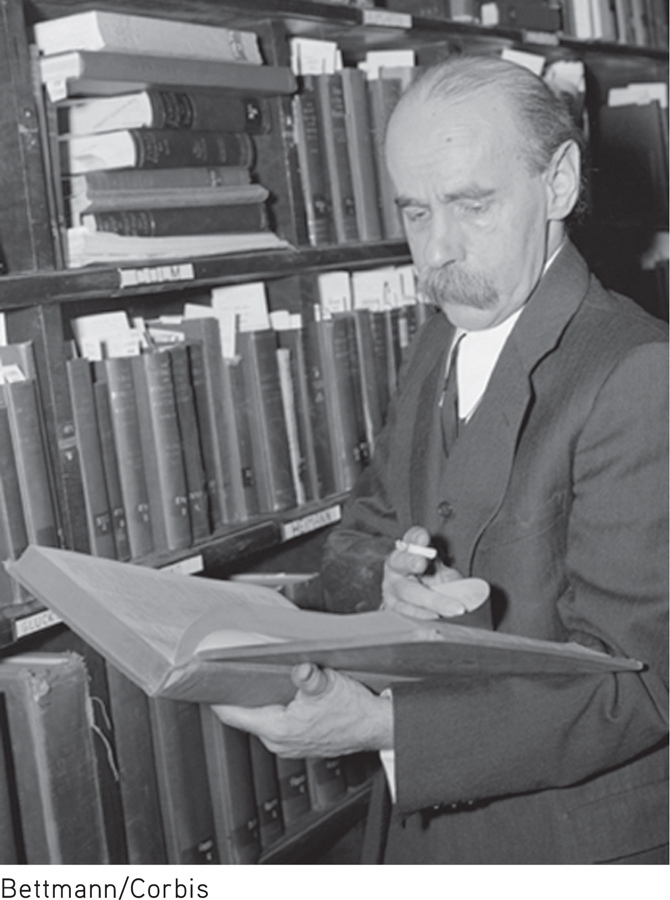
Gestalt psychology
(geh-SHTALT) School of psychology that maintained sensations are actively processed according to consistent perceptual rules, producing meaningful whole perceptions, or gestalts.
Question 3.18
wc8FFLUqKyzJ6bYYRYqxb6JrieGrFEkB5Aop1PvtyOxCdeGtlio2Wj8DHzzCNLt5iwziNVrmGmeo8y7stI4kyWWRaAdbpVV6oYl/uHyTP8XP4uiQu4AFRKvCeoHzYA7t2idt20gw6xiGhM4WsoLX6HYBRnLyYl92iCXpU/gojpCOTXXF0qauiv6VeJ2mM13ffoKWVcz7F+LPw6MDOpk0H6Ro4QDDCCmqGreVlnZC70ZLHMpcThe Perception of Shape: WHAT IS IT?
When you look around your world, you don’t see random edges, curves, colors, or splotches of light and dark. Rather, you see countless distinct objects against a variety of backgrounds. Although to some degree we rely on size, color, and texture to determine what an object might be, we rely primarily on an object’s shape to identify it.
CULTURE AND HUMAN BEHAVIOR
Ways of Seeing: Culture and Top-Down Processes
Do people in different cultures perceive the world differently? In Chapter 1, we described two types of cultures. Unlike people in individualistic cultures, who tend to emphasize independence, people in collectivistic cultures see humans as being enmeshed in complex relationships. This social perspective is especially pronounced in the East Asian cultures of Korea, Japan, and China, where a person’s sense of self is highly dependent upon his or her social context (Beins, 2011). Consequently, East Asians pay much closer attention to the social context in which their own actions, and the actions of others, occur (Nisbett, 2007; Varnum & others, 2010).
The Cultural Eye of the Beholders
Do these cultural differences in social perspective influence visual perception and memory? Take a few seconds to look at the photo on the right. Was your attention drawn by the tiger? Or its surroundings?
In one study, Hannah Faye Chua and her colleagues (2005) used sophisticated eye-tracking equipment to monitor the eye movements of U.S. and Chinese students while they looked at similar photographs that showed a single focal object against a realistic, complex background. The results showed that their eye movements differed: The U.S. students looked sooner and longer at the focal object in the foreground than the Chinese students did. In contrast, the Chinese students spent more time looking at the background than the U.S. students did. And, the Chinese students were also less likely to recognize the foreground objects when they were placed in front of a new background.
Rather than separating the object from its background, the Chinese students tended to see—and remember—object and background as a single perceptual image. Many psychologists believe that this pattern of results reflects the more “holistic” perceptual style that characterizes collectivistic cultures (Boduroglu & others, 2009; Boland & others, 2008).
Similarly, Joshua Goh and his colleagues (2009) compared the visual response of U.S. and East Asian participants to changes in photographs. They found that U.S. participants paid more attention to changes in the objects, but East Asian participants paid more attention to changes in the background. The U.S. participants also tended to focus their attention on the object alone, while the East Asian participants alternated looking at the object and the background, paying more attention to the relationship between the object and background. “Culture,” the researchers observed, “may operate as a top-down mechanism that guides and interacts with basic neuro-perceptual processes.”
Cultural Comfort Zones and Brain Functioning
Many psychologists now believe that these cultural differences in social and perceptual style also influence brain function (Park & Huang, 2010). For example, psychologist Trey Hedden and his colleagues (2008) compared brain functioning in East Asian and U.S. participants while they made rapid perceptual judgments comparing two images of a square with an embedded line as shown in this image on the right.
The relative task involved determining if the lines in the two images were in the same proportion to the surrounding squares. The absolute task involved determining whether the two lines were the same absolute length, regardless of the size of the squares (see figure). Each participant made these judgments while his or her brain activity was tracked by an fMRI scanner.
Both groups were equally proficient at the task and used the same brain regions in making the simple perceptual judgments. However, the pattern of brain activation differed.
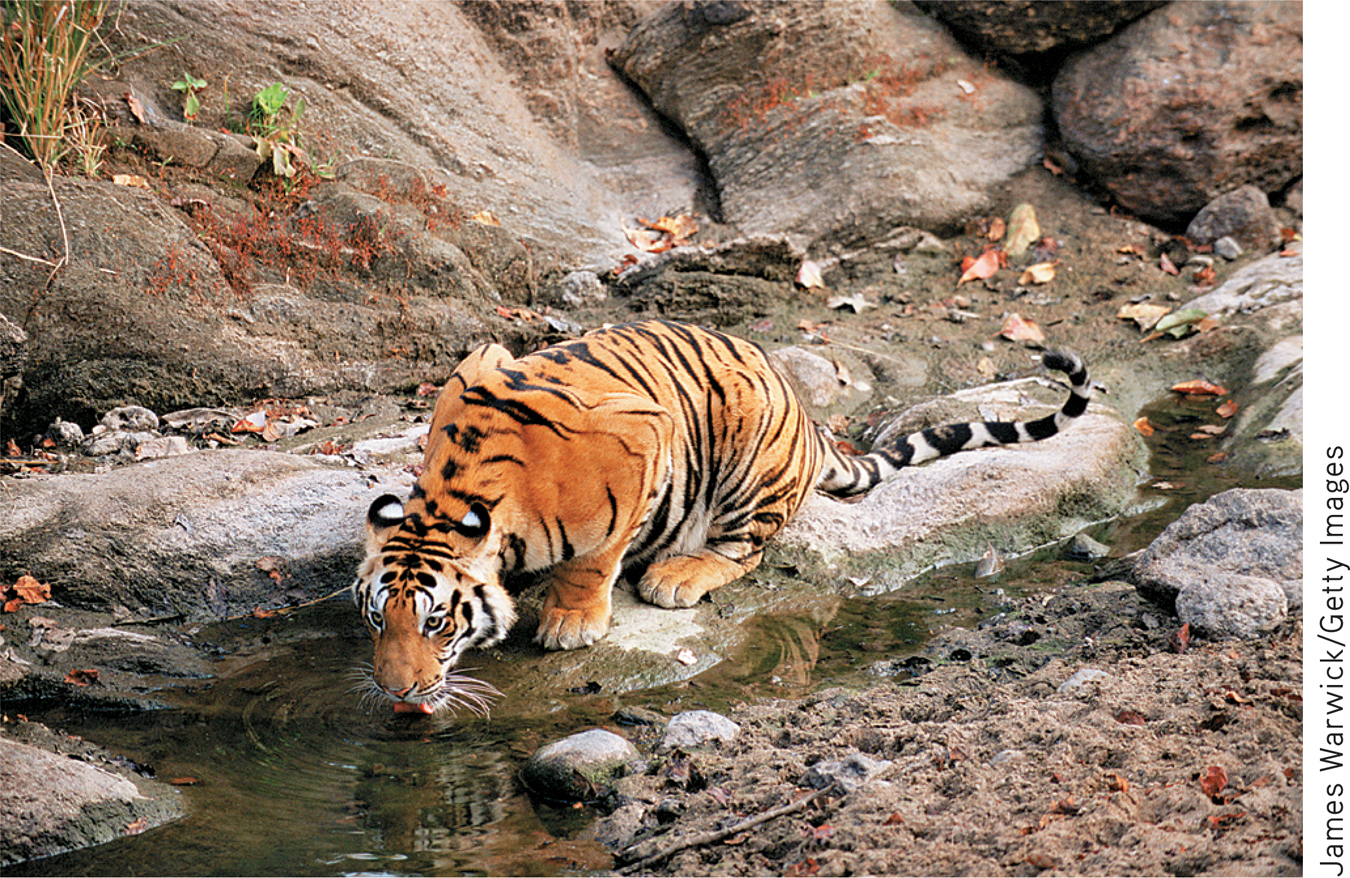
The individualistic U.S. participants showed greater brain activation while making relative judgments, meaning they had to exert more mental effort. The collectivistic East Asians showed the opposite pattern, devoting greater brain effort to making absolute judgments that required them to ignore the context. Essentially, all participants had to work harder at making perceptual judgments that were outside their cultural comfort zones.
The bottom line? People from different cultures use the same neural processes to make perceptual judgments. But, their culture trains them to use them in different ways. As John Gabrieli (2008) points out, “The way in which the brain responds to these simple drawings reflects, in a predictable way, how the individual thinks about independent or interdependent social relationships.” People from different cultures may not literally see the world differently—but they notice different things and think differently about what they do see.

Courtesy of Trey Hedden/McGovern Institute, MIT
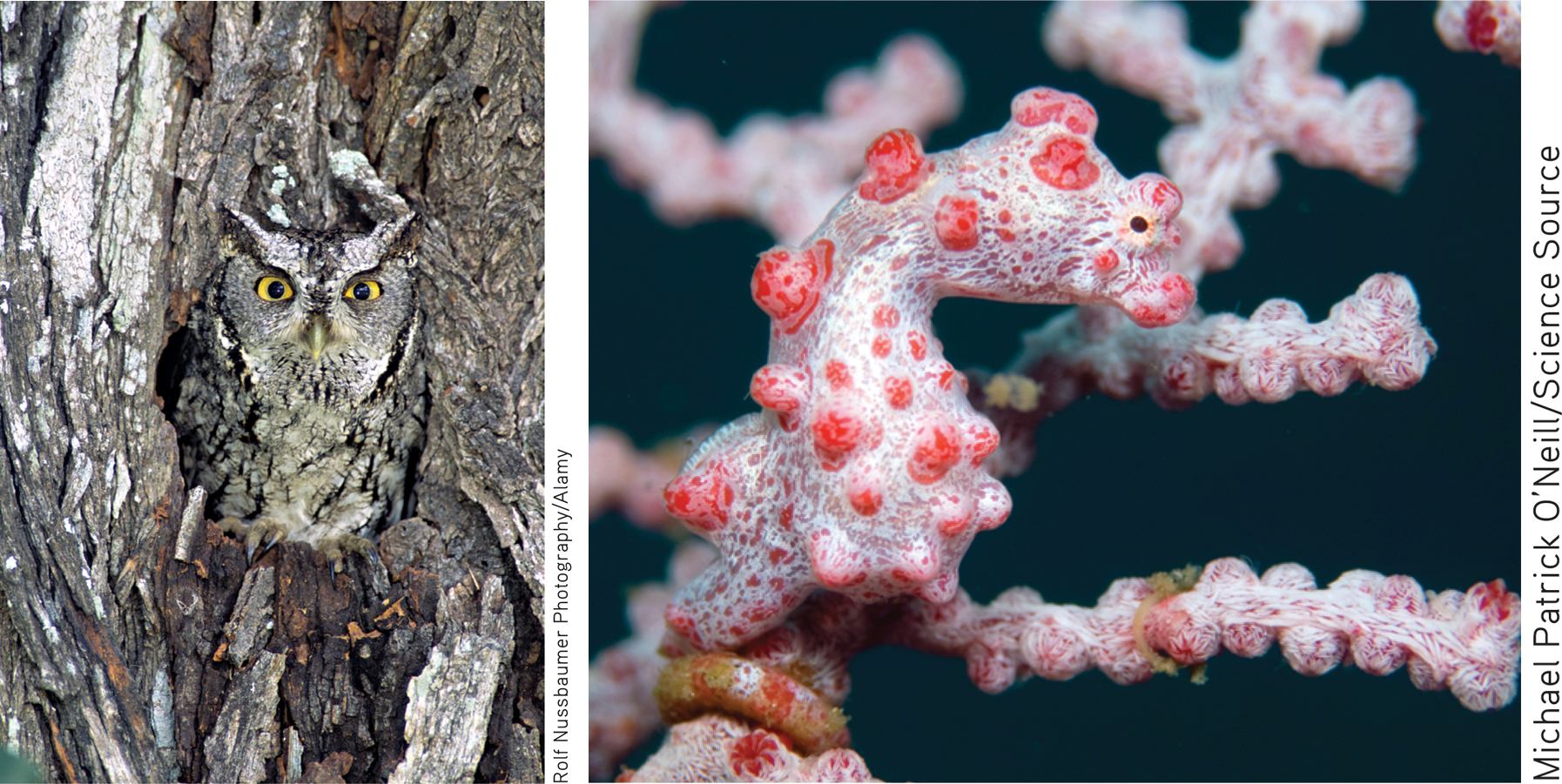
Michael Patrick O’Neill/Science Source
FIGURE–GROUND RELATIONSHIP
How do we organize our perceptions so that we see an object as separate from other objects? The early Gestalt psychologists identified an important perceptual principle called the figure-ground relationship, which describes how this works. When we view a scene, we automatically separate the elements of that scene into the figure, which is the main element of the scene, and the ground, which is its background.
figure–ground relationship
Gestalt principle stating that a perception is automatically separated into the figure, which clearly stands out, from its less distinct background, the ground.
You can experience the figure–
The early Gestalt psychologists noted that figure and ground have vastly different perceptual qualities (N. Rubin, 2001). As Gestalt psychologist Edgar Rubin (1921) observed, “In a certain sense, the ground has no shape.” We notice the shape of the figure but not the shape of the background, even when that ground is used as a well-defined frame (see FIGURE 3.13). It turns out that brain neurons also respond differently to a stimulus that is perceived as a figure versus a stimulus that is part of the ground (Baylis & Driver, 2001). Particular neurons in the cortex that responded to a specific shape when it was the shape of the figure did not respond when the same shape was presented as part of the background.

The separation of a scene into figure and ground is not a property of the actual elements of the scene at which you’re looking. Rather, your ability to separate a scene into figure and ground is a psychological accomplishment. To illustrate, look at the classic example shown in FIGURE 3.14. This perception of a single image in two different ways is called a figure–
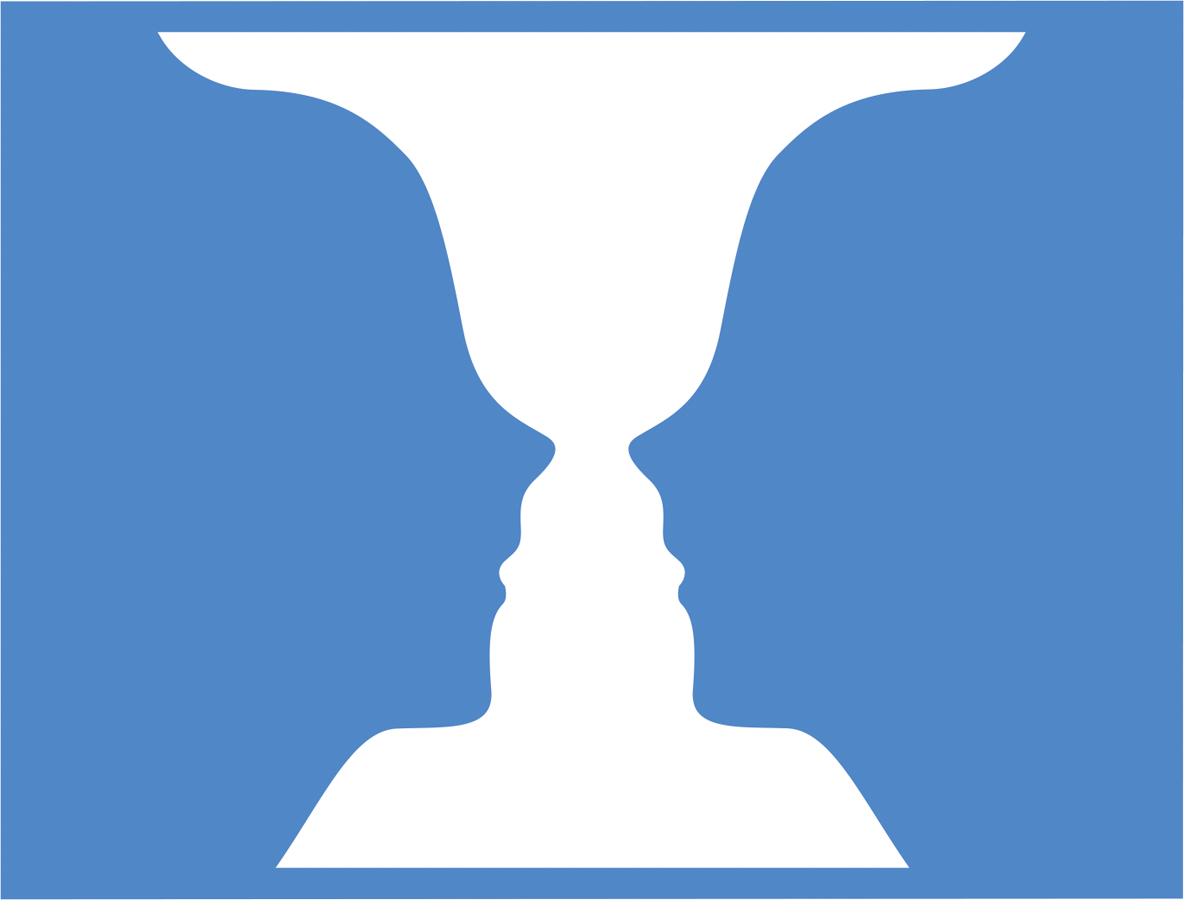

PERCEPTUAL GROUPING
Many of the forms we perceive are composed of a number of different elements that seem to go together (Glicksohn & Cohen, 2011). It would be more accurate to say that we actively organize the elements to try to produce the stable perception of well-defined, whole objects. This is what perceptual psychologists refer to as “the urge to organize.” What principles do we follow when we attempt to organize visual elements?
The Gestalt psychologists studied how the perception of visual elements becomes organized into patterns, shapes, and forms. They identified several laws, or principles, that we tend to follow in grouping elements together to arrive at the perception of forms, shapes, and figures. These principles include similarity, closure, good continuation, and proximity. Examples and descriptions of these perceptual laws are shown in FIGURE 3.15.
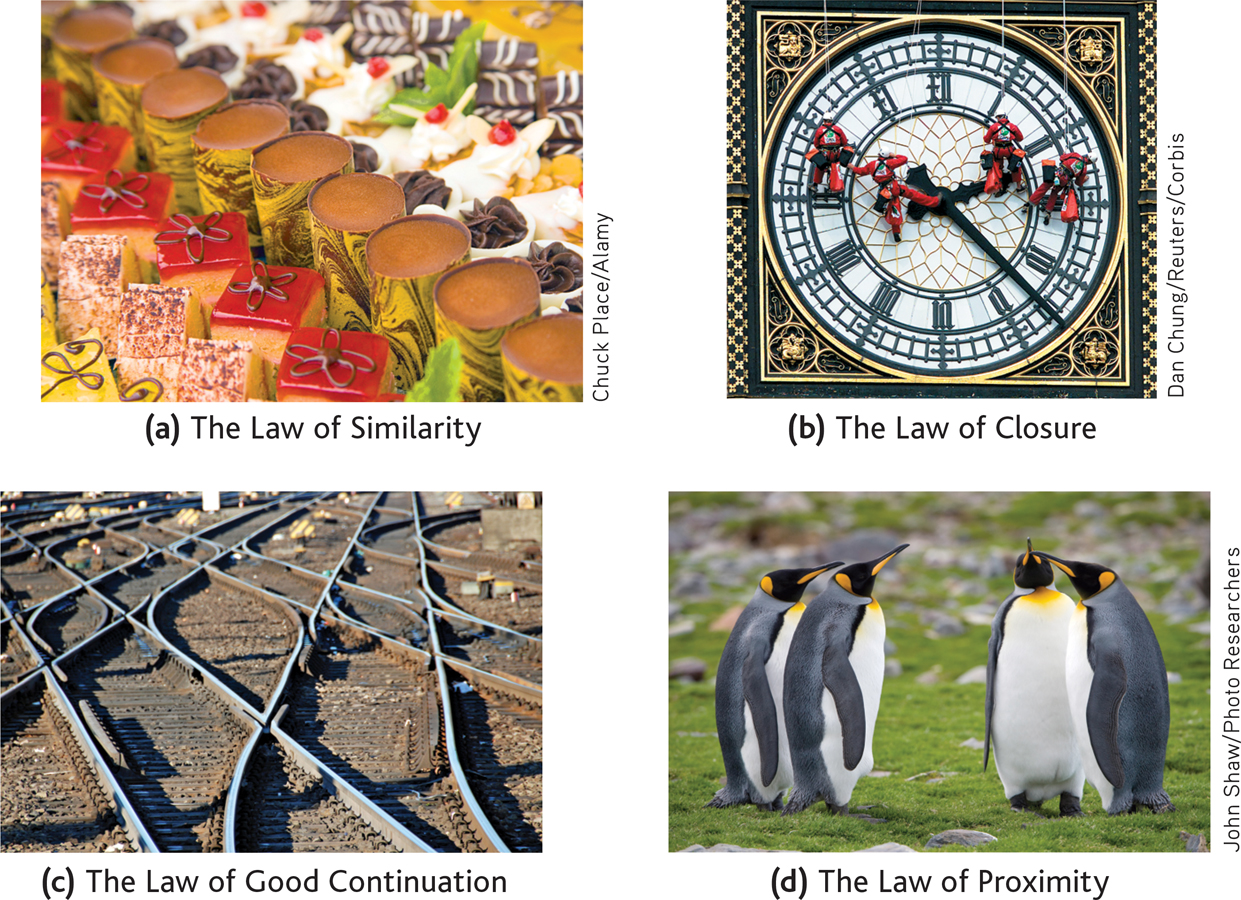
(a) The law of similarity is the tendency to perceive objects of a similar size, shape, or color as a unit or figure. Thus, you perceive organized rows of chocolates and truffles rather than a mixed array.
(b) The law of closure is the tendency to fill in the gaps in an incomplete image. Thus, you perceive the curved lines on the clock as smooth, continuous circles, even though they are interrupted by workers and the clock’s hands.
(c) The law of good continuation is the tendency to group elements that appear to follow in the same direction as a single unit or figure. Thus, you tend to see the curved sections of rails as continuous units, and the straight sections as other continuous units.
(d) The law of proximity is the tendency to perceive objects that are close to one another as a single unit. Thus, you perceive these four penguins as two sets of penguin couples rather than as a single group of four penguins.
Dan Chung/Reuters/Corbis
John Shaw/Photo Researchers
The Gestalt psychologists also formulated a general principle called the law of Prägnanz, or the law of simplicity. This law states that when several perceptual organizations of an assortment of visual elements are possible, the perceptual interpretation that occurs will be the one that produces the “best, simplest, and most stable shape” (Koffka, 1935). For an illustration, look at FIGURE 3.16. Do you perceive the image as two six-sided objects and one four-sided object? If you are following the law of Prägnanz, you don’t. Instead, you perceptually organize the elements in the most cognitively efficient and simple way, perceiving them as three overlapping squares.

According to the Gestalt psychologists, the law of Prägnanz encompasses all the other Gestalt principles, including the figure–
Depth Perception: HOW FAR AWAY IS IT?
KEY THEME
Perception of distance and motion helps us gauge the position of stationary objects and predict the path of moving objects.
KEY QUESTIONS
What are the monocular and binocular cues for distance or depth perception, and how does binocular disparity explain our ability to see three-dimensional forms in two-dimensional images?
What visual cues help us perceive distance and motion?
Why do we perceive the size and shape of objects as unchanging despite changes in sensory input?
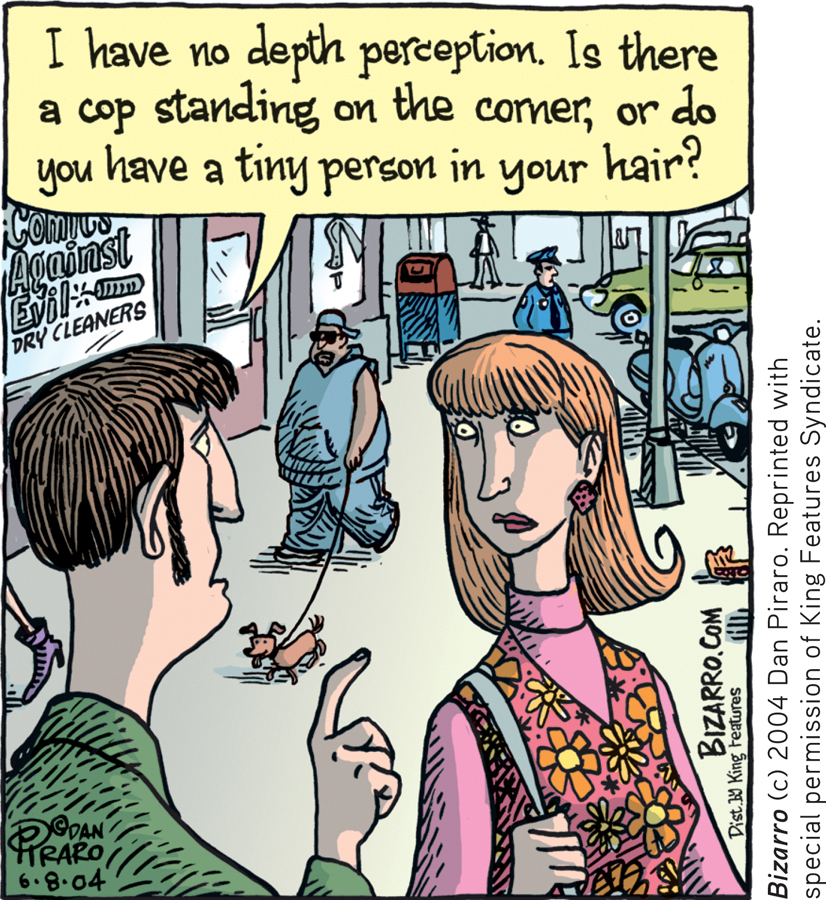
Being able to perceive the distance of an object has obvious survival value, especially regarding potential threats, such as snarling dogs or oncoming trains. But simply walking through your house or apartment also requires that you accurately judge the distance of furniture, walls, other people, and so forth. Otherwise, you’d be constantly bumping into doors, walls, and tables. The ability to perceive the distance of an object as well as the three-dimensional characteristics of an object is called depth perception.
depth perception
The use of visual cues to perceive the distance or three-dimensional characteristics of objects.
MONOCULAR CUES
We use a variety of cues to judge the distance of objects. Monocular cues require the use of only one eye (mono means “one”). When monocular cues are used by artists to create the perception of distance or depth in paintings or drawings, they are called pictorial cues. After familiarizing yourself with these cues, look at the photographs below. Try to identify the monocular cues you used to determine the distance of the objects in each photograph.
monocular cues
(moe-NOCK-you-ler) Distance or depth cues that can be processed by either eye alone.
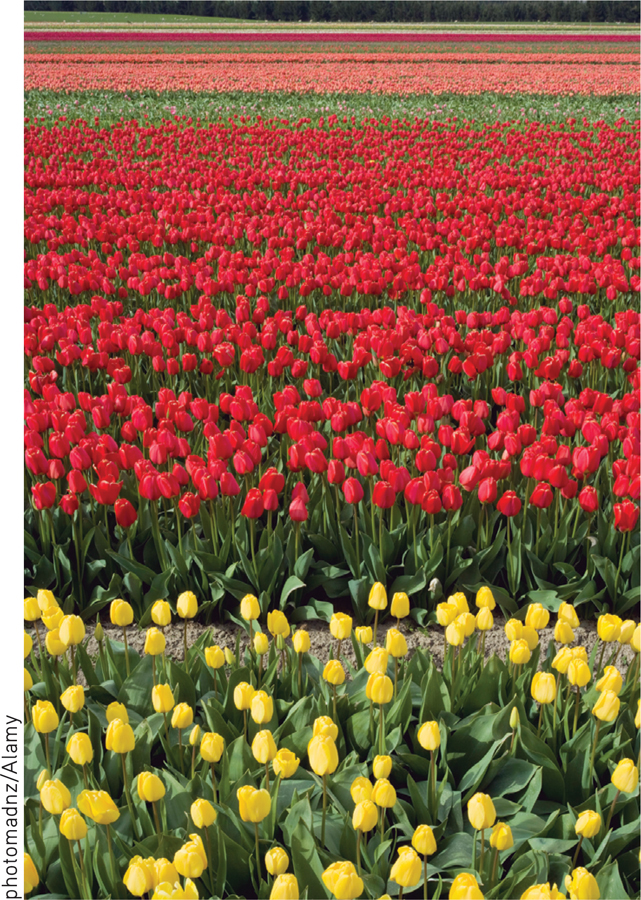
Relative size. If two or more objects are assumed to be similar in size, the object that appears larger is perceived as being closer.
Overlap. When one object partially blocks or obscures the view of another object, the partially blocked object is perceived as being farther away. This cue is also called interposition.
Aerial perspective. Faraway objects often appear hazy or slightly blurred by the atmosphere.
Texture gradient. As a surface with a distinct texture extends into the distance, the details of the surface texture gradually become less clearly defined. The texture of the surface seems to undergo a gradient, or continuous pattern of change, from crisp and distinct when close to fuzzy and blended when farther away.
Linear perspective. Parallel lines seem to meet in the distance. For example, if you stand in the middle of a railroad track and look down the rails, you’ll notice that the parallel rails seem to meet in the distance. The closer together the lines appear to be, the greater the perception of distance.
 Relative Size, Linear Perspective, and Aerial Perspective Several monocular depth cues are operating in this photograph. Relative size is particularly influential: The very small image of the jogger and the decreasing size of the street lamps contribute to the perception of distance. Linear perspective is evident in the apparent convergence of the walkway railings. Aerial perspective contributes to the perception of depth from the hazy background.Superstock
Relative Size, Linear Perspective, and Aerial Perspective Several monocular depth cues are operating in this photograph. Relative size is particularly influential: The very small image of the jogger and the decreasing size of the street lamps contribute to the perception of distance. Linear perspective is evident in the apparent convergence of the walkway railings. Aerial perspective contributes to the perception of depth from the hazy background.Superstock Motion Parallax This photograph of waiters in India passing a tray from one train car to the next captures the visual flavor of motion parallax. Objects that whiz by faster are perceptually judged as being closer, as in the case here of the blurred ground and bushes. Objects that pass by more slowly are judged as being farther away, as conveyed by the clearer details of buildings and more distant objects.Steve McGurry/Magnum Photos
Motion Parallax This photograph of waiters in India passing a tray from one train car to the next captures the visual flavor of motion parallax. Objects that whiz by faster are perceptually judged as being closer, as in the case here of the blurred ground and bushes. Objects that pass by more slowly are judged as being farther away, as conveyed by the clearer details of buildings and more distant objects.Steve McGurry/Magnum PhotosMotion parallax. When you are moving, you use the speed of passing objects to estimate the distance of the objects. Nearby objects seem to zip by faster than do distant objects. When you are riding on a commuter train, for example, houses and parked cars along the tracks seem to whiz by, while the distant downtown skyline seems to move very slowly.
Another monocular cue is accommodation. Unlike pictorial cues, accommodation utilizes information about changes in the shape of the lens of the eye to help us estimate distance. When you focus on a distant object, the lens is flat, but focusing on a nearby object causes the lens to thicken. Thus, to some degree, we use information provided by the muscles controlling the shape of the lens to judge depth. In general, however, we rely more on pictorial cues than on accommodation for depth perception.
BINOCULAR CUES
Binocular cues for distance or depth perception require information from both eyes. One binocular cue is convergence—the degree to which muscles rotate your eyes to focus on an object. The more the eyes converge, or rotate inward, to focus on an object, the greater the strength of the muscle signals and the closer the object is perceived to be. For example, if you hold a dime about six inches in front of your nose, you’ll notice the slight strain on your eye muscles as your eyes converge to focus on the coin. If you hold the dime at arm’s length, less convergence is needed. Perceptually, the information provided by these signals from your eye muscles is used to judge the distance of an object.
binocular cues
(by-NOCK-you-ler) Distance or depth cues that require the use of both eyes.
Another binocular distance cue is binocular disparity. Because our eyes are set a couple of inches apart, a slightly different image of an object is cast on the retina of each eye. When the two retinal images are very different, we interpret the object as being close by. When the two retinal images are more nearly identical, the object is perceived as being farther away (Parker, 2007).
Here’s a simple example that illustrates how you use binocular disparity to perceive distance. Hold a pencil just in front of your nose. Close your left eye, then your right.
These images are quite different—that is, there is a great deal of binocular disparity between them. Thus you perceive the pencil as being very close. Now focus on another object across the room and look at it first with one eye closed, then the other. These images are much more similar. Because there is less binocular disparity between the two images, the object is perceived as being farther away. Finally, notice that with both eyes open, the two images are fused into one.
A stereogram is a picture that uses the principle of binocular disparity to create the perception of a three-dimensional image (Kunoh & Takaoki, 1994). Look at the stereogram shown below. When you first look at it, you perceive a two-dimensional picture of leaves. Although the pictorial cues of overlap and texture gradient provide some sense of depth to the image, the elements in the picture appear to be roughly the same distance from you.
However, a stereogram is actually composed of repeating columns of carefully arranged visual information. If you focus as if you are looking at some object that is farther away from the stereogram, the repeating columns of information will present a slightly different image to each eye. This disparate visual information then fuses into a single image, enabling you to perceive a three-dimensional image—three rabbits! To see the rabbits, follow the directions in the caption.
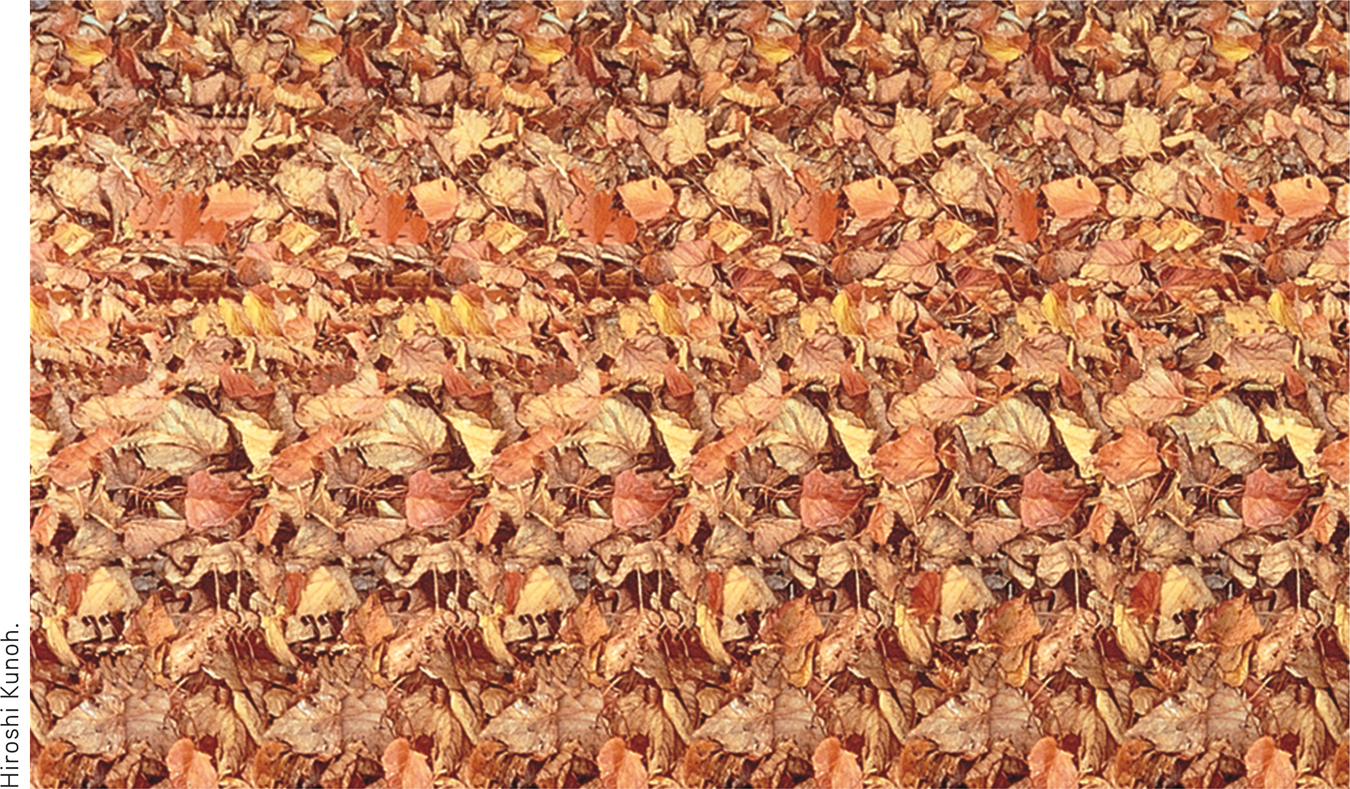
Question 3.19
VGT/R5KWAkqBCEh/R59XR54FA6nq0hRmgPXHVjsI47Nzo8Evbz5Zxt+DZLleHmfkzEK4yjTC6J1A09/jjV17R7avs0OwZoI94SPKdCTWYcNUrQRPRpQkewtB1uzHeoN8MawzB0O6wHMPzNT8Mpeslprt9eEWMByqwotX2wJP1N98YZfdflbbk4wp2ltzcAju9859ACh6cyrD5usVQMDsNkUwKUZ9JLtgNVeBDg6Dem7QQtQ1M7caEfMMHAJl9O4sHnDHt3Clg76RyZOOp8undcX7znKs6ZcjxUunQd1hi59RsgwVpo/wFQ==CONCEPT REVIEW 3.3
Depth Perception
Several monocular depth cues are evident in this photograph of a palace complex in Bangkok, Thailand. See if you can identify examples of the following depth cues:

Question 3.20
| 1. | Relative size |
Relative size. The people, trees, and lampposts toward the bottom of the photo seem closer because they are larger than those toward the center of the photo.
Question 3.21
| 2. | Overlap |
Overlap. Many object in the photograph are partially obscured by other object - such as the trees, lampposts, windows, and towers. In each case, the object that is not obscured is perceived as being closer.
Question 3.22
| 3. | Aerial perspective |
Aerial perspective. The towers toward the top of the photo are fuzzy and slightly blurred, and thus they ae perceived as being farther away.
Question 3.23
| 4. | Texture gradient |
Texture gradient. Details of the cobblestones, people, trees, and lampposts are crisp in the foreground but become progressively more blurred as you move toward the top of the photograph.
Question 3.24
| 5. | Linear perspective |
Linear perspective. The cobblestones and the lines of trees and lampposts seem to be converging toward the middle of the photo, creating a sense of greater distance.
The Perception of Motion: WHERE IS IT GOING?
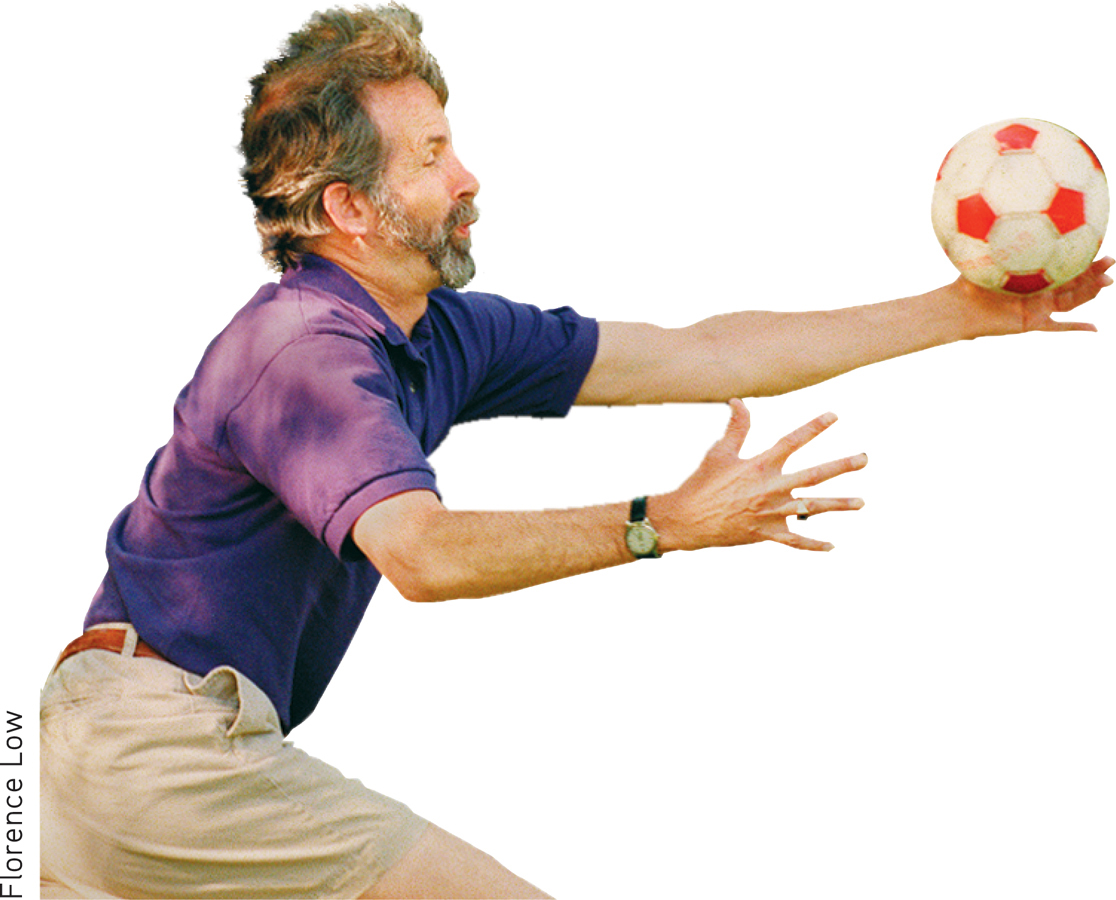
In addition to the ability to perceive the distance of stationary objects, we need the ability to gauge the path of moving objects, whether it’s a baseball whizzing through the air, a falling tree branch, or an egg about to roll off the kitchen counter. How do we perceive movement?
As we follow a moving object with our gaze, the image of the object moves across the retina. Our eye muscles make microfine movements to keep the object in focus. We also compare the moving object to the background, which is usually stationary. When the retinal image of an object enlarges, we perceive the object as moving toward us. Our perception of the speed of the object’s approach is based on our estimate of the object’s rate of enlargement (Harris & others, 2008). Neural pathways in the brain combine information about eye-muscle activity, the changing retinal image, and the contrast of the moving object with its stationary background. The end result? We perceive the object as moving.
Neuroscientists do not completely understand how the brain’s visual system processes movement. It’s known that some neurons are highly specialized to detect motion in one direction but not in the opposite direction. Other neurons are specialized to detect motion at one particular speed. Research also shows that different neural pathways in the cerebral cortex process information about the depth of objects, movement, form, and color (Regan & Gray, 2009; Zeki, 2001).
Psychologically, we tend to make certain assumptions when we perceive movement. For example, we typically assume that the object, or figure, moves while the background, or frame, remains stationary (Rock, 1995). Thus, as you visually follow a bowling ball down the alley, you perceive the bowling ball as moving and not the alley, which serves as the background.

Because we have a strong tendency to assume that the background is stationary, we sometimes experience an illusion of motion called induced motion. Induced motion was first studied by Gestalt psychologist Karl Duncker (1903–
Why did subjects perceive the dot as moving? Part of the explanation has to do with top-down processing. Perceptually, Duncker’s subjects expected to see the smaller dot move within the larger rectangular frame, not the other way around. If you’ve ever looked up at a full moon on a windy night when the clouds were moving quickly across its face, you’ve probably experienced the induced motion effect. The combination of these environmental elements makes the moon appear to be racing across the sky.
Another illusion of apparent motion is called stroboscopic motion. First studied by Gestalt psychologist Max Wertheimer in the early 1900s, stroboscopic motion creates an illusion of movement with two carefully timed flashing lights (Wertheimer, 1912). A light briefly flashes at one location, followed about a tenth of a second later by another light briefly flashing at a second location. If the time interval and distance between the two flashing lights are just right, a very compelling illusion of movement is created.
What causes the perception of stroboscopic motion? Although different theories have been proposed, researchers aren’t completely sure. The perception of motion typically involves the movement of an image across the retina. However, during stroboscopic motion the image does not move across the surface of the retina. Rather, the two different flashing lights are detected at two different points on the surface of the retina. Somehow, the brain’s visual system combines this rapid sequence of visual information to arrive at the perceptual conclusion of motion, even though no movement has occurred. The perception of smooth motion in a movie is also due to stroboscopic motion.
Perceptual Constancies
Consider this scenario. As you’re driving on a flat stretch of highway, a red SUV zips past you and speeds far ahead. As the distance between you and the SUV grows, its image becomes progressively smaller until it is no more than a dot on the horizon. Yet, even though the image of the SUV on your retinas has become progressively smaller, you don’t perceive the vehicle as shrinking. Instead, you perceive its shape, size, and brightness as unchanged.
This tendency to perceive objects, especially familiar objects, as constant and unchanging despite changes in sensory input is called perceptual constancy. Without this perceptual ability, our perception of reality would be in a continual state of flux. If we simply responded to retinal images, our perceptions of objects would change as lighting, viewing angle, and distance from the object changed from one moment to the next. Instead, the various forms of perceptual constancy promote a stable view of the world.
perceptual constancy
The tendency to perceive objects, especially familiar objects, as constant and unchanging despite changes in sensory input.
SIZE AND SHAPE CONSTANCY

Size constancy is the perception that an object remains the same size despite its changing image on the retina. When our distance from an object changes, the image of the object that is cast on the retinas of our eyes also changes, yet we still perceive it to be the same size. The example of the red SUV illustrates the perception of size constancy. As the distance between you and the red SUV increased, you could eventually block out the retinal image of the vehicle with your hand, but you don’t believe that your hand has suddenly become larger than the SUV. Instead, your brain automatically adjusts your perception of the vehicle’s size by combining information about retinal image size and distance.
size constancy
The perception of an object as maintaining the same size despite changing images on the retina.
An important aspect of size constancy is that if the retinal image of an object does not change but the perception of its distance increases, the object is perceived as larger. To illustrate, try this: Stare at a 75-watt light bulb for about 10 seconds. Then focus on a bright, distant wall. You should see an afterimage of the light bulb on the wall that will look several times larger than the original light bulb. Why? When you looked at the wall, the lingering afterimage of the light bulb on your retina remained constant, but your perception of distance increased. When your brain combined and interpreted this information, your perception of the light bulb’s size increased. Remember this demonstration. We’ll mention it again when we explain how some perceptual illusions occur.
Shape constancy is the tendency to perceive familiar objects as having a fixed shape regardless of the image they cast on our retinas. Try looking at a familiar object, such as a door, from different angles, as in the photograph on the left. Your perception of the door’s rectangular shape remains constant despite changes in its retinal image. Shape constancy has a greater influence on your perceptions than you probably realize (see FIGURE 3.17).

shape constancy
The perception of a familiar object as maintaining the same shape regardless of the image produced on the retina.